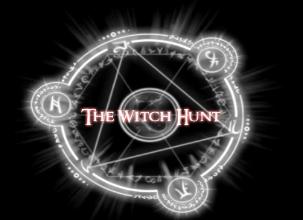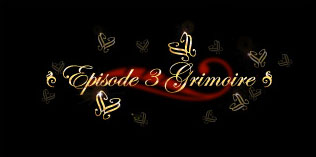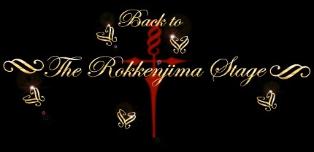This page will explain some bits of Japanese language and culture, as well as other
general notes, which you will need to know in order to fully understand
Ryuukishi07's world. Spoilers will be kept to a minimum and will all be limited to
Episode 3, but we will mention various events that occur throughout that Episode.
Chapter 1
Ore and Watashi
Ore (俺/オレ) a the pronoun used by boys and young men in general, an informal “I” that
denotes familiarity among friends and family, but also masculinity and superiority towards their
peers or people of lower status.
Watashi (私) is the neutral and formal pronoun for “I”, that can be used by anyone, regardless
their gender or status.
Changing such use of pronoun is not really usual, especially involving oneself. Switching from
ore to watashi may be a sign that the person is trying to sound more serious, rather than simply
masculine.
Why don't you just give up and die?
This is 'Young' Eva's catch phrase. Literally, it means something along the lines of 'Why not bite
your belly button and die?' The 'biting' part is a phase that means trying to do something
completely hopeless. For hopefully obvious reasons, we chose to use the actual meaning of the
phrase in the translation, but its literal meaning may also be important.
Chapter 2
Scholar’s mate
Specific type of Checkmate. Often occurring among beginners, this is a four-move checkmate that
involves a combined attack of both the bishop and the queen as soon as the pawn in front of the
king has been moved. The queen is placed diagonally, aiming for the opposing king, while the
bishop is facing the opposing knight. By doing so, one would only need to move the queen ,
capturing the pawn and threatening the king for a checkmate, as the bishop would prevent the
opposing king from capturing the queen.
Chapter 5
Play the opening like a book, the middle game like a magician, and the endgame like a
machine.
Famous quote from Rudolf Spielmann, a chess writer.
Chapter 7
Sons of Ivaldi
The 4 sons of Ivaldi were master craftmen dwarves in Norse Mythology.
They were known to have crafted the following objects:
Sif, the magic gold wig which replaced Thor’s wife’s hair, which Loki had cut off
Skidbladnir, Freyr’s collapsible boat
Gungnir, Odin’s spear.
Gungnir
This invincible divine weapon given to Odin by Loki was known to never miss its mark and to
always return to Odin’s hands.
Epaulette mate
Specific type of checkmate. The checked king has its side squares occupied by his own pieces,
which prevents him from escaping. Generally speaking, the most common case of such
checkmate involves the king on his back rank, sandwiched by both rooks.
Hephaestus
Greek god of blacksmiths, craftsmen, and technology. He has crafted many artifacts for the gods
and heroes, such like Hercules’ bronze clappers, Eros’ bow and Achilles’ armor.
Aegis Shield
Zeus’ divine garment, crafted by Hephaestus. Originally a cloak of tasseled gold goatskin, the
aegis was worn by Zeus as a symbol of his power, protecting him and frightening his enemies.
Due to its fearsome properties, it was often considered to be Zeus’ breastplate.
It is later shown as Athena’s usual robe, with the gorgon embossed on its center, after Perseus
defeated Medusa and offered her head to the goddess.
Aegis is known to be a divine form of protection in many myths, though its most common
incarnation is a shield or buckler.
It is the law of the gods that an absolute spear and an absolute shield must not fight each
other.
Reference to the unstoppable force paradox: what happens when an irresistible force meets an
immovable object?
As a side note, in Chinese and Japanese, the word for contradiction or paradox (矛盾) is made up of
the kanji for spear (矛) and shield (盾).
It was the legendary hammer that had shaken the King of the Frost Giants.
This is a reference to Thor’s almighty hammer, Mjöllnir. One of the most fearsome weapons in
Norse Mythology, Mjöllnir allowed Thor to crush any foe.
Back rank mate
Specific type of Checkmate. This one is delivered by either the queen or a rook as the mated king
is stuck on the back rank due to his own pieces blocking his way on the second rank.
...inside the moon was the figure of a massive horse ridden by the god of war and death.
Reference to Gungnir’s rightful owner, Odin himself. In Norse Mythology, Odin is the highest
god, and associated with wisdom, war and death.
Smothered mate
Specific type of checkmate. A knight puts the opposing king in checkmate when the later is
cornered by his own pieces.
Chapter 8
Virgilius
Also known as Virgil, he was the one who guided Dante on his pilgrimage through hell and
purgatory in the Divine Comedy.
Ironically enough, in the Divine Comedy, Dante loved a woman named Beatrice, and she guided
him through heaven.
The Japanese pronunciation of this name is “Walgirias” (ワルギリアス) which is pretty close to
Valkyria (ワルキュリア).
Chapter 12
Gateau au Chocolat
This French word literally means “chocolate cake”. It is actually a category of cakes that have of
course a significant portion of chocolate, such like the Black Forest Cake, Sachertorte, etc.
Chapter 14
In the very end, she noticed that I was pinning the rook and the king.
A pin in chess is a situation where a piece is unable to move because it would expose a more
valuable piece otherwise. An absolute pin is when the pinned piece is defending the king, and it
is therefore impossible to move the pinned piece as it would leave the king in check.
Please note this situation is different from a “fork”.
Chapter 17
Fool’s mate
This is the 2 move checkmate, the quickest situation known in chess. This only occurs when
white is playing extremely poorly, advancing both pawns of f and g files.
The result is that black can simply open the way of his queen with his pawn in e file, then as a
second move, place the queen on h4, leading to a checkmate.
Chapter 18
Naniwa-bushis
A kind of theatrical narrative and singing focused on human feelings and stories of loyalty.
Like this.
Galge (ギャルゲー)
Contraction for Gal Games (Girl games). This is a synonym for the archetype of games in Japan,
known as Bishoujo games, which involve beautiful girls as the name implies.
Tea Party
Remember, that girl said it a lot, right? 'Why don't you somthi~ng?', right?! Yes, that phrase
is the main point! Evaa~? Evaa~? Yes! She was actually, Ushiromiya Eva!!
This is actually a pun that was unfortunately not possible to convert into English. Actually,
Young Eva/Eva-Beatrice uses “死んじゃえば” in her catchphrase, which gives “Shinjaeba” in
romaji. The last portion, “えば/eba” is actually how you pronounce Eva’s name (絵羽) in Japanese.
Kakera
Literally “fragment” or “piece”. This word can have a very important meaning depending on
how it is used, and because of its direct link with Higurashi no Naku Koro ni.
This word represents the worlds in the “Naku Koro ni” series: the kakera are the “dimensions”
or “worlds”, numerous and scattered in an alternative universe, where fate and probabilities can
be visualized.
general notes, which you will need to know in order to fully understand
Ryuukishi07's world. Spoilers will be kept to a minimum and will all be limited to
Episode 3, but we will mention various events that occur throughout that Episode.
Chapter 1
Ore and Watashi
Ore (俺/オレ) a the pronoun used by boys and young men in general, an informal “I” that
denotes familiarity among friends and family, but also masculinity and superiority towards their
peers or people of lower status.
Watashi (私) is the neutral and formal pronoun for “I”, that can be used by anyone, regardless
their gender or status.
Changing such use of pronoun is not really usual, especially involving oneself. Switching from
ore to watashi may be a sign that the person is trying to sound more serious, rather than simply
masculine.
Why don't you just give up and die?
This is 'Young' Eva's catch phrase. Literally, it means something along the lines of 'Why not bite
your belly button and die?' The 'biting' part is a phase that means trying to do something
completely hopeless. For hopefully obvious reasons, we chose to use the actual meaning of the
phrase in the translation, but its literal meaning may also be important.
Chapter 2
Scholar’s mate
Specific type of Checkmate. Often occurring among beginners, this is a four-move checkmate that
involves a combined attack of both the bishop and the queen as soon as the pawn in front of the
king has been moved. The queen is placed diagonally, aiming for the opposing king, while the
bishop is facing the opposing knight. By doing so, one would only need to move the queen ,
capturing the pawn and threatening the king for a checkmate, as the bishop would prevent the
opposing king from capturing the queen.
Chapter 5
Play the opening like a book, the middle game like a magician, and the endgame like a
machine.
Famous quote from Rudolf Spielmann, a chess writer.
Chapter 7
Sons of Ivaldi
The 4 sons of Ivaldi were master craftmen dwarves in Norse Mythology.
They were known to have crafted the following objects:
Sif, the magic gold wig which replaced Thor’s wife’s hair, which Loki had cut off
Skidbladnir, Freyr’s collapsible boat
Gungnir, Odin’s spear.
Gungnir
This invincible divine weapon given to Odin by Loki was known to never miss its mark and to
always return to Odin’s hands.
Epaulette mate
Specific type of checkmate. The checked king has its side squares occupied by his own pieces,
which prevents him from escaping. Generally speaking, the most common case of such
checkmate involves the king on his back rank, sandwiched by both rooks.
Hephaestus
Greek god of blacksmiths, craftsmen, and technology. He has crafted many artifacts for the gods
and heroes, such like Hercules’ bronze clappers, Eros’ bow and Achilles’ armor.
Aegis Shield
Zeus’ divine garment, crafted by Hephaestus. Originally a cloak of tasseled gold goatskin, the
aegis was worn by Zeus as a symbol of his power, protecting him and frightening his enemies.
Due to its fearsome properties, it was often considered to be Zeus’ breastplate.
It is later shown as Athena’s usual robe, with the gorgon embossed on its center, after Perseus
defeated Medusa and offered her head to the goddess.
Aegis is known to be a divine form of protection in many myths, though its most common
incarnation is a shield or buckler.
It is the law of the gods that an absolute spear and an absolute shield must not fight each
other.
Reference to the unstoppable force paradox: what happens when an irresistible force meets an
immovable object?
As a side note, in Chinese and Japanese, the word for contradiction or paradox (矛盾) is made up of
the kanji for spear (矛) and shield (盾).
It was the legendary hammer that had shaken the King of the Frost Giants.
This is a reference to Thor’s almighty hammer, Mjöllnir. One of the most fearsome weapons in
Norse Mythology, Mjöllnir allowed Thor to crush any foe.
Back rank mate
Specific type of Checkmate. This one is delivered by either the queen or a rook as the mated king
is stuck on the back rank due to his own pieces blocking his way on the second rank.
...inside the moon was the figure of a massive horse ridden by the god of war and death.
Reference to Gungnir’s rightful owner, Odin himself. In Norse Mythology, Odin is the highest
god, and associated with wisdom, war and death.
Smothered mate
Specific type of checkmate. A knight puts the opposing king in checkmate when the later is
cornered by his own pieces.
Chapter 8
Virgilius
Also known as Virgil, he was the one who guided Dante on his pilgrimage through hell and
purgatory in the Divine Comedy.
Ironically enough, in the Divine Comedy, Dante loved a woman named Beatrice, and she guided
him through heaven.
The Japanese pronunciation of this name is “Walgirias” (ワルギリアス) which is pretty close to
Valkyria (ワルキュリア).
Chapter 12
Gateau au Chocolat
This French word literally means “chocolate cake”. It is actually a category of cakes that have of
course a significant portion of chocolate, such like the Black Forest Cake, Sachertorte, etc.
Chapter 14
In the very end, she noticed that I was pinning the rook and the king.
A pin in chess is a situation where a piece is unable to move because it would expose a more
valuable piece otherwise. An absolute pin is when the pinned piece is defending the king, and it
is therefore impossible to move the pinned piece as it would leave the king in check.
Please note this situation is different from a “fork”.
Chapter 17
Fool’s mate
This is the 2 move checkmate, the quickest situation known in chess. This only occurs when
white is playing extremely poorly, advancing both pawns of f and g files.
The result is that black can simply open the way of his queen with his pawn in e file, then as a
second move, place the queen on h4, leading to a checkmate.
Chapter 18
Naniwa-bushis
A kind of theatrical narrative and singing focused on human feelings and stories of loyalty.
Like this.
Galge (ギャルゲー)
Contraction for Gal Games (Girl games). This is a synonym for the archetype of games in Japan,
known as Bishoujo games, which involve beautiful girls as the name implies.
Tea Party
Remember, that girl said it a lot, right? 'Why don't you somthi~ng?', right?! Yes, that phrase
is the main point! Evaa~? Evaa~? Yes! She was actually, Ushiromiya Eva!!
This is actually a pun that was unfortunately not possible to convert into English. Actually,
Young Eva/Eva-Beatrice uses “死んじゃえば” in her catchphrase, which gives “Shinjaeba” in
romaji. The last portion, “えば/eba” is actually how you pronounce Eva’s name (絵羽) in Japanese.
Kakera
Literally “fragment” or “piece”. This word can have a very important meaning depending on
how it is used, and because of its direct link with Higurashi no Naku Koro ni.
This word represents the worlds in the “Naku Koro ni” series: the kakera are the “dimensions”
or “worlds”, numerous and scattered in an alternative universe, where fate and probabilities can
be visualized.


